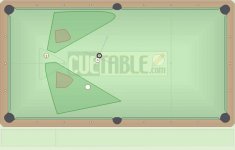This should be almost automatic DCP. There are two ways to control the amount of backspin put on the cueball, how low you hit and how hard you hit. For small draw I will mostly use my standard shot weight with as much 'low' as needed for the draw ... perhaps 1/2 tip for a couple of inches, 3/4 tip for 3-4 inches, etc. This can be mastered by practice, and only by practice. Here is a funny little exercise that I made up. Set up a short, straight-in shot (like the 8 ball in your diagram). Hit it very very hard with a dead-center hit on the cuball. That should be a stop shot (note if the cb is spinning, it shouldn't be, and if it is you are hitting off the vertical axis). Do the same very very hard hit with a teeny-weeny bit of bottom (hit about 1/4 tip below center). That should be a small draw, say 3" or so. Play with this very very hard stroke for a while to become familiar with how much draw/follow you get with what tip offset. Now repeat the exersize hitting very hard (as opposed to very very hard). Note that it will take a bit more tip offset to get the same 3" draw. Repeat again with a hard stroke, a medium-hard stroke, a medium stroke, a medium-light .... etc etc. This will demonstrate the many strokes that can be used to get 9" of draw, it is a whole range of shots from "hard-with-minimal-bottom" to "soft-with-serious-bottom". Which one is most comfortable to shoot will be up to you. Again, for myself I try to shoot them with my natural speed (which for me is a bit stronger than a lag-for-break stroke), but you gotta know how much tip-offset to use for specific draw distances, hence the practice. This is such a fundamental skill (being able to draw-back or follow-on a SPECIFIC distance) that it should be practiced a lot.
Dave
